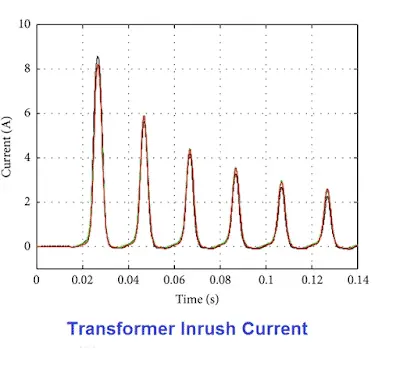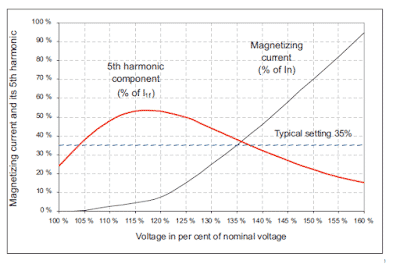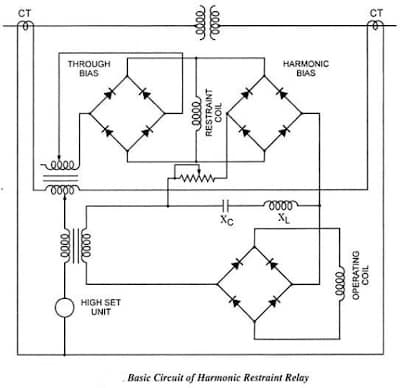Harmonic restraining in differential protection is a technique used in transformer protection to prevent false tripping during inrush or over-fluxing conditions by detecting and blocking specific harmonic currents—mainly the 2nd and 5th harmonics—commonly present during non-fault events.
Purpose of Differential Protection
The differential relay is used for the protection of the transformer, alternator, and large-rating HT motor. The differential protection scheme is also known as zone protection. The relay must trip in case of a fault in the winding of the transformer. If the fault is outside the zone, the differential relay must remain inoperative.
Inrush Current During Transformer Energization
The transformer draws a large current at the time of switching on of the transformer at no load. The large current drawn by the transformer is known as the inrush current or magnetizing inrush current.
The magnitude of the inrush current maybe 8 to 10 times or even larger than this. The magnitude and duration of the inrush current depend on the instant of the AC waveform at which the transformer is switched on.
The waveform of the transformer inrush current is given below.

Read detailed Article on: Transformer Magnetizing Inrush Current
Differential Relay Misoperation Risk During Charging
The secondary current is zero, and the primary current is high at the time of the transformer’s charging. This difference in current between primary and secondary may lead to the operation of a differential protection relay.
Thus, it is not possible to charge the transformer. If the protection relay is bypassed, the differential protection of the transformer will be defeated. Bypassing the differential protection relay is not the solution.
Role of Harmonics During Transformer Energization
The transformer generates a 2nd- and 5th-order harmonic current at the time of charging because of the nonlinear B-H characteristics of magnetic flux. The magnetic flux in the core is not sinusoidal, and the transformer generates harmonics.
This introduces the presence of the 2nd harmonic in transformer and 5th harmonic in transformer, which are key indicators of non-fault conditions like energization or over-fluxing.
The sensing of the harmonics and restraining the differential protection relay operation at the time of the transformer’s charging is one of the solutions. This requirement is fulfilled by harmonic restraining in the differential protection of the transformer.
Fourier Analysis and 2nd Order Harmonic Current
If we analyze the magnetizing inrush current by the Fourier series, it has 2nd and 5th-order harmonics. The 2nd order harmonic is rich when the transformer draws magnetizing current at the time of switching of the transformer.
This is a direct reflection of the 2nd harmonic in transformer conditions seen during initial energization.
The frequency of the 2nd order harmonics is 100 Hz. The differential relay has a 100 Hz filter circuit, which measures the frequency and the magnitude of the 2nd-order harmonic current in the differential current.
Blocking of Differential Relay During Inrush
If the relay senses the current of 100 Hz frequency and if the current is more than the differential current setting of the relay, the relay will observe that the transformer is taking the inrush magnetizing current.
The relay blocks its main tripping mechanism. Therefore, the 2nd-order harmonic current needs to be blocked in the differential relay because the 2nd-order harmonic current will operate under no fault within the transformer.
This is called 2nd harmonic blocking, used to avoid unnecessary relay operation during energization.
Harmonic Restsraint Differential Protection Scheme
Harmonic Current Blocking Feature
Thus, the harmonic current blocking is an important feature of the differential protection relay. In the harmonic restraint differential protection scheme, the harmonic restraint differential relay has the 2nd,3rd, and 5th order harmonic blocking circuit and the differential protection circuits.
These harmonic filters serve as the core of a robust harmonic protection system
Second Harmonic Restraint
If the inrush current contains a predominant 2nd-order harmonic current, it is a symptom of transformer energization, and differential protection is supposed to be blocked during normal transformer energization.
If the ratio of the second harmonic current to the fundamental is greater than the 2nd-order harmonic current set point, the relay blocks the differential operation because it sees this condition as transformer energization.
This is a form of 2nd harmonic blocking in the relay logic.
Setting the 2nd-Order Harmonic Blocking Level
The magnitude of 2nd order harmonic current in inrush current depends on transformer material, construction, and remanence. Therefore, the setting of the 2nd-order harmonic blocking current can not be calculated in a straightforward way.
The relay measures the ratio of the 2nd-order harmonic current and the fundamental current, and the setting of the 2nd-order harmonic blocking current can be done accordingly.
Typical Harmonic Reststraining Setting
The setting of the 2nd order harmonic restraining is generally kept between 20-25 % of the differential relay setting.
If the current is below the differential relay setting, the relay does not trip because the relay will observe it as a transformer charging phenomenon. If the harmonic restraining current is more than the differential relay setting, the relay will trip with the differential protection fault.
5th-Order Harmonic in Over-Fluxing Condition
Over-Fluxing and 5th-Order Harmonic Current
During the over-fluxing of the transformer, the transformer current has a predominant 5th-order harmonic current. The over-fluxing happens when there is a sudden rise in voltage or a sudden drop in the frequency.
This is a key sign of 5th harmonic in transformer current during over-excitation.
The measurement of 5th-order harmonic current is very important for over-excitation monitoring of the transformer. The magnitude of the 5th-order harmonic current under over-excitation depends on the magnetization curve of the transformer.
Tripping Logic Under Over-Fluxing
The differential protection relay will trip in case of over-fluxing. If the over-fluxing happens for a short period of time, the differential relay should not trip.
Therefore, to prevent the operation of differential protection relay in case of over fluxing, 5th order harmonic restraining is provided. The 5th-order harmonic current varies as the voltage applied to the transformer increases from its rated voltage.
This enhances the transformer’s harmonic protection scheme.

Order of Harmonics During Transformer Charging
If the magnitude of the 5th-order harmonic current is more than the setting of the differential protection relay setting, the relay will trip. If the magnitude of the 5th-order harmonic current is less than the setting of the differential protection relay setting, the relay will not trip.
This detection is crucial for the function of the harmonic restraint relay under abnormal flux condition
The setting of the 5th-order harmonic restraining is generally kept between 20- 25 % of the differential relay setting.
Basic Circuit of Harmonic Restraining Relay
The basic circuit of the harmonic restraint relay is given below.

The harmonic restraining elements of the relay measure the magnitude of the harmonic current, and tripping of the relay is restrained if the harmonic current is well below the specified current.
Note-If the transformer has been out of use for some time (i.e. after storage) its remanence may be very small, causing the 2nd harmonic blocking not to operate at the first energizing attempt. Therefore, the setting could be lowered to 10% for the first energizing attempt.
Key Takeaways
- 2nd harmonic blocking helps avoid relay misoperation during transformer energization (inrush condition).
- 5th harmonic restraint protects against nuisance tripping under over-fluxing or over-excitation.
- Harmonic restraint differential relays monitor and compare harmonic levels to fundamental currents for intelligent decision-making.
- Typical restraint settings are 20–25% of the differential current to balance sensitivity and stability.
- Harmonic analysis is a crucial feature in modern transformer differential protection schemes to distinguish between fault and non-fault conditions.
Conclusion
Harmonic restraining in differential protection plays a vital role in preventing false tripping of transformer relays during non-fault conditions such as inrush and over-fluxing.
By analyzing the presence of 2nd and 5th harmonics in transformer currents, protection systems can intelligently block relay operation and ensure reliable performance.
The use of harmonic restraint differential relays improves the stability and selectivity of transformer protection schemes, especially under dynamic operating conditions. Correct setting and understanding of harmonic blocking thresholds are essential for effective transformer operation and longevity.
FAQs – Harmonic Restraint in Transformers
The purpose of 2nd harmonic blocking is to prevent false operation of the differential relay during transformer energization. When a transformer is switched on, it draws a large magnetizing inrush current rich in 2nd harmonic components. The relay uses this harmonic to identify non-fault conditions and block unnecessary tripping.
2nd and 5th harmonics in transformer are critical indicators of inrush and over-fluxing conditions, respectively. The differential protection scheme detects these harmonics to restrain relay operation during normal non-fault events, ensuring reliable transformer protection.
A harmonic restraint differential relay is a type of protective relay that detects specific harmonic currents—especially the 2nd and 5th—and restrains or blocks tripping when these harmonics indicate non-fault situations like inrush current or over-excitation.
The 5th harmonic in transformer currents becomes prominent during over-fluxing or over-excitation. Its detection allows the differential relay to differentiate between actual internal faults and over-fluxing, helping avoid nuisance tripping.
Harmonic protection in transformers refers to the relay’s ability to monitor harmonic content in current signals. By identifying harmonics such as the 2nd during energization and the 5th during over-fluxing, the relay ensures secure and selective tripping only during genuine fault conditions.
Related Articles: